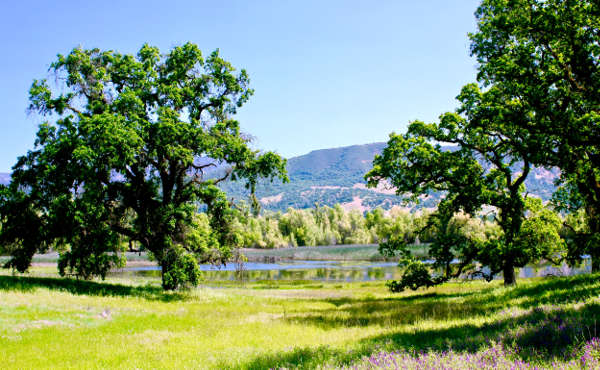LAKE COUNTY, Calif. – Pacific Gas and Electric reported Saturday afternoon that it has completed the process of restoring power to 738,000 customers in 34 counties who were impacted in a public safety power shutoff that began on Wednesday.
The company said it initiated the shutoff – believed to be the largest of its kind carried out by any utility in the state – in response to a wind event that brought with it increased fire risk.
In Lake County, the all clear was given on Thursday afternoon to begin system inspections in order to restore power to the more than 37,409 customer accounts that had been shut off.
Power began to come on across Lake County on Thursday night, with the restoration process continuing through Friday and into Saturday.
Sumeet Singh, PG&E’s vice president for asset and risk management and the Community Wildfire Safety Program, said at a press briefing that the company on Saturday had confirmed 50 instances of weather-related damage to its system in the shutoff-impacted areas, and were reviewing another 100 locations with potential damage.
As examples, he showed pictures of trees and branches that had fallen into overhead power lines in Glenn, Shasta and Napa counties.
A map presented at the briefing appeared to indicate four damage locations in Lake County, with a total of 13 overall in the North Bay.
Bill Johnson, PG&E’s president and CEO, emphasized that safety – and no other motivation – was behind the shutoff.
“These outages were intended solely – solely – to keep our communities safe from wildfire. And we achieved that purpose. We did not have catastrophic wildfire in our service area here in Northern and Central California like the ones going on in Southern California at the moment, despite the fact that winds that surpassed our safety threshold were blowing over vast, dry areas,” he said.
Johnson said vegetation coming into contact with energized distribution lines is the primary cause of fires involving electrical equipment.
“We will do better in communicating with all of our customers in future events,” Johnson said.
He thanked partners at various state and local agencies and the thousands of PG&E employees and contractors who had inspected 25,000 miles of line – a distance he pointed out is the same circumference as the Earth – and restored power to the impacted customers within 48 hours of the all clear.
Johnson acknowledged that the shutoff was not popular and that, as a result, PG&E has been the subject of intense scrutiny and criticism over the past week.
He addressed several misconceptions and story lines in the public, including PG&E turning off power to save its own skin or that its system was in shambles.
“What is true is the risk of wildfire has grown exponentially,” said Johnson, with more of PG&E’s system now in high fire threat areas.
He explained that in 2012, the state’s high fire threat area designation applied to 15 percent of PG&E’s system. This year, more than half of the system is in the high fire threat area.
“The fire risk geography has more than tripled in seven years,” he said, noting that more than 120 million trees across the state are dead, dying or diseased. “All of this has happened with unnerving speed.”
One of the ways PG&E can deal with the threat is turning off the power. “It’s the opposite of what we want to do,” said Johnson.
Johnson, who took over the leadership of PG&E earlier this year, admitted that PG&E has given people little reason in recent years to trust it because of events in which it didn’t keep people safe.
He said the company is trying to live up to its commitments and intends to earn back that trust.
Email Elizabeth Larson atThis email address is being protected from spambots. You need JavaScript enabled to view it. . Follow her on Twitter, @ERLarson, or Lake County News, @LakeCoNews.
The company said it initiated the shutoff – believed to be the largest of its kind carried out by any utility in the state – in response to a wind event that brought with it increased fire risk.
In Lake County, the all clear was given on Thursday afternoon to begin system inspections in order to restore power to the more than 37,409 customer accounts that had been shut off.
Power began to come on across Lake County on Thursday night, with the restoration process continuing through Friday and into Saturday.
Sumeet Singh, PG&E’s vice president for asset and risk management and the Community Wildfire Safety Program, said at a press briefing that the company on Saturday had confirmed 50 instances of weather-related damage to its system in the shutoff-impacted areas, and were reviewing another 100 locations with potential damage.
As examples, he showed pictures of trees and branches that had fallen into overhead power lines in Glenn, Shasta and Napa counties.
A map presented at the briefing appeared to indicate four damage locations in Lake County, with a total of 13 overall in the North Bay.
Bill Johnson, PG&E’s president and CEO, emphasized that safety – and no other motivation – was behind the shutoff.
“These outages were intended solely – solely – to keep our communities safe from wildfire. And we achieved that purpose. We did not have catastrophic wildfire in our service area here in Northern and Central California like the ones going on in Southern California at the moment, despite the fact that winds that surpassed our safety threshold were blowing over vast, dry areas,” he said.
Johnson said vegetation coming into contact with energized distribution lines is the primary cause of fires involving electrical equipment.
“We will do better in communicating with all of our customers in future events,” Johnson said.
He thanked partners at various state and local agencies and the thousands of PG&E employees and contractors who had inspected 25,000 miles of line – a distance he pointed out is the same circumference as the Earth – and restored power to the impacted customers within 48 hours of the all clear.
Johnson acknowledged that the shutoff was not popular and that, as a result, PG&E has been the subject of intense scrutiny and criticism over the past week.
He addressed several misconceptions and story lines in the public, including PG&E turning off power to save its own skin or that its system was in shambles.
“What is true is the risk of wildfire has grown exponentially,” said Johnson, with more of PG&E’s system now in high fire threat areas.
He explained that in 2012, the state’s high fire threat area designation applied to 15 percent of PG&E’s system. This year, more than half of the system is in the high fire threat area.
“The fire risk geography has more than tripled in seven years,” he said, noting that more than 120 million trees across the state are dead, dying or diseased. “All of this has happened with unnerving speed.”
One of the ways PG&E can deal with the threat is turning off the power. “It’s the opposite of what we want to do,” said Johnson.
Johnson, who took over the leadership of PG&E earlier this year, admitted that PG&E has given people little reason in recent years to trust it because of events in which it didn’t keep people safe.
He said the company is trying to live up to its commitments and intends to earn back that trust.
Email Elizabeth Larson at

 How to resolve AdBlock issue?
How to resolve AdBlock issue? 


















